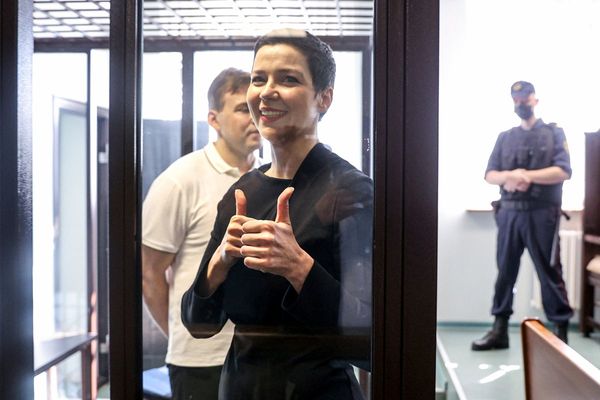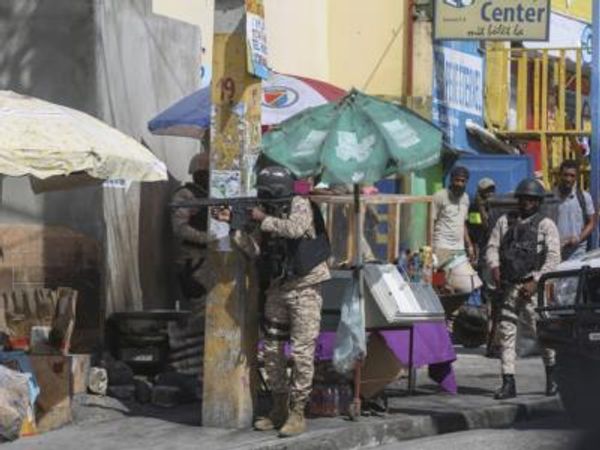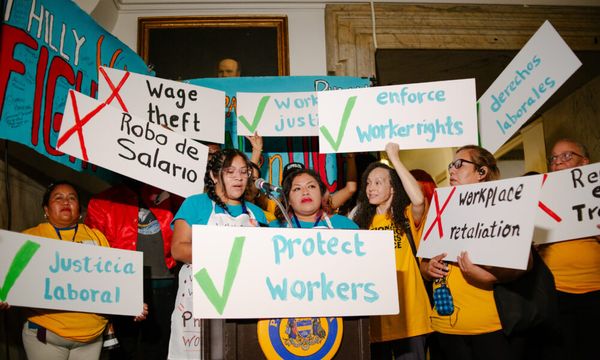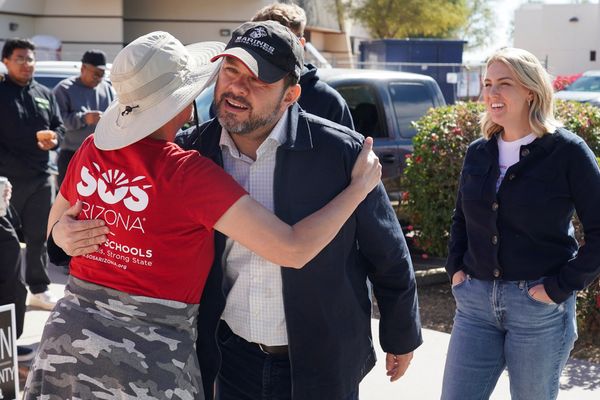
In Esiteti, a Maasai village in southern Kenya, Pilale Rikoiyan cooks a large pot of rice for her grandchildren. While she and her family have adjusted to having plain grain whenever they run out of produce or are low on meat, preparing the meal makes her nostalgic for the days when her homestead owned several heads of cattle. The herd guaranteed a consistent supply of meat and milk, and an income for produce and other needs.
“Life has changed so much from that time,” says 69-year-old Rikoiyan. “We never used to work so hard daily to put food on the table.”
A prolonged drought that has gripped the country and the wider horn of Africa has made life more challenging for women in pastoralist communities, who bear primary responsibility for securing food, water and fuel.

Pilale Rikoiyan, 69, splits wood from a tree brought down by strong winds after being weakened by drought. Fetching firewood is an important role in Maasai homesteads
The growing care burden of these women on the frontline of the climate crisis is the subject of a recent photo series by Maasai photographers Claire Metito and Irene Naneu. Chronicling the everyday experiences of two elderly women, the photographers provide an intimate view of the increased, and often undervalued, domestic load that they shoulder.
Metito and Naneu were among 14 women in Kenya and Ghana who took part in a programme by Lensational, a social enterprise that supports underrepresented women to learn photography and document the changes happening in their lives on issues such as climate breakdown.
Metito chose to depict her mother-in-law Rikoiyan’s experiences because the matriarch’s life reflects the harsh realities that have become normalised, even among the women themselves. Rikoiyan and other women in their seven-family household go to great lengths to care for sick cattle and keep their herd alive, but they have lost most of their cows to the drought in recent years, and have to rely for milk on goats, which produce only a fraction of the supply.

Rikoiyan milks her cow while its calf waits to suckle. Having a milking cow in a Maasai homestead is considered prestigious, but the drought means few families have even one milk-producing cow left. Rikoiyan will share the milk with her children and grandchildren
As their herd dwindles and food insecurity grows, so does the demand for care work. Children get sick more often due to malnourishment, meaning that women devote more time nursing them back to health.
Metito, a nursery school teacher and mother of four, sees Rikoiyan wake up at the break of dawn each morning to begin housework and childcare as Metito and other women in their multigenerational household trek for hours to find firewood and grazing sites for their cattle, hoping to get as much done as they can before the afternoon, when heat stress slows them down. Grasslands have thinned out due to the drought, so they need to walk several kilometres further than they used to.
“This is a real and authentic look into her life – into all of our lives,” says Metito, who lives in Rikoiyan’s homestead. “The work you see her doing is something we’re all familiar with. It is hard, but we’ve become used to it, so it’s no longer something that is seen as out of the ordinary.”




While the younger members of the family tend cattle on distant pastures, Rikoiyan cares for her grandchildren and weaker and sick livestock, many of which have eye injuries from grazing among thorny thickets due to lack of grass. She supplements her income by making beadwork to sell
Women’s climate networks say that governments need to provide social safety nets and alternative livelihoods for those whose needs and responsibilities have become heightened by the crisis, and to invest in infrastructure that supports women from marginalised communities.
Closer health facilities in Esiteti, for instance, would allow women to spend less time managing the healthcare needs of their family, community members say. And proper roads would increase market traders’ access to the village and reduce the time women spend securing food. Currently, traders only venture into the village once a week because the roads are in poor condition, so women need to cross over to neighbouring Tanzania each week, a walk of several hours each way.
Female photographers trained by Lensational say visual storytelling is a powerful tool for their community, which faces marginalisation and illiteracy, and a way to disrupt the barriers that often keep their realities and perspectives from full view.

Lenoi Mayiempe’s farmhand guides her cattle across a section of her land. In addition to her role as a caregiver for her grandchildren, she prepares meals for those who tend to her cattle
Naneu’s images capture the life of Lenoi Mayiempe, a farmer from Narok in southern Kenya, who is the primary guardian of her two grandchildren. Mayiempe has managed to keep many heads of cattle despite the drought, but faces challenges getting water as rivers and dams dry up. Unpredictable rain patterns have made it difficult to count on a healthy yield, so she leases out part of her land to community members to manage the risk. She began managing the property after her husband died, but it belongs to her two sons. Gender norms that restrict land ownership by women also expose them to vulnerability.
“In Narok, women are the ones who rear cattle, fetch water and look after the kids,” says Naneu. “They take care of the wealth but husbands control it, so many women have unmet needs and end up suffering in silence.”




Clockwise from top left: Mayiempe milks her cows; shaves her granddaughter’s head ready for the new school term; plays with her grandchildren outside her compound; and inspects her corn cobs, many of which are underdeveloped and unfit to eat due to drought
Naneu and Metito say their photography work has allowed them to share authentic representations of Maasai women, reignited their interest in everyday happenings in their communities, and enabled them to understand the issues they face more deeply.
“Getting behind the camera and hearing how people are being affected, that’s when I truly understood the extent of the situation we are facing with climate change,” says Naneu.

With the ongoing drought, Mayiempe has to travel to where these two valleys converge to fetch water. Despite her disability and the curvature of her legs, she remains capable of managing her daily tasks






